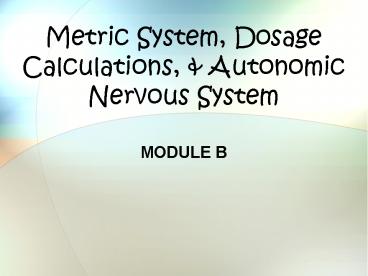Metric System, Dosage Calculations, - PowerPoint PPT Presentation
Title:
Metric System, Dosage Calculations,
Description:
Title: PowerPoint Presentation Author: migliov Last modified by: Rick Zahodnic Created Date: 10/5/2001 3:54:53 PM Document presentation format: On-screen Show – PowerPoint PPT presentation
Number of Views:380
Avg rating:3.0/5.0
Title: Metric System, Dosage Calculations,
1
Metric System, Dosage Calculations, Autonomic
Nervous System
- MODULE B
2
Objectives
- At the end of the module you will
- Given a prefix, state the related power of 10.
- Define solute, solvent, and solution.
- Given two of the following three parameters,
solve for the third Percent of Solution, Mass of
drug (in grams or milligrams), Volume of drug (in
mL or L). - Calculate the body surface area, given a height,
weight, and the Dubois Nomogram.
3
Objectives
- At the end of the module you will
- Describe the divisions of the central and
peripheral nervous systems. - Define key terms relative to pharmacology of the
autonomic nervous system. - Describe the anatomy, neurotransmitters, and
receptors of the autonomic nervous system. - State four classifications of autonomic nervous
system drugs on the basis of how and where they
work. - Relate the pharmacology of the autonomic nervous
system to the "specific chapters" and drug
classifications that are relevant.
4
Metric System Prefixes and Abbreviations
5
Unit Conversions
- If a patient voids 3.2 liters of urine in a day,
what is the average urine output in mL/hr?
3.2 L x 1000 mL 3,200 mL 1.0 L 3,200
mL x 1 day 133 mL day 24 hrs hr
6
Definitions
- Solute Liquid or solid dissolved in a liquid.
- Solvent The liquid that dissolves the solute.
- Solution A chemical and physical homogenous
mixture of two or more substances.
7
(No Transcript)
8
Percentage and Ratio Solutions
- Percentage Solutions
- A 20 solution means that there are 20 grams of
solute for every 100 mL of solution. - Example
- Ratio Solution
- A 1200 solution means that there is 1 mg of
solute in 200 mL of solution - Example
9
Dosage Calculation
- How many mg of active ingredient are there in 4.0
mL of 1200 albuterol?
10
Easy Way
- mL x x 10 mg
11
- Dubois Nomogram
- Height 72 inches
- Weight 190 pounds
- What is the BSA?
12
Nervous System
13
CNS
PNS
14
Nervous System Divisions
AFFERENT
EFFERENT
15
Somatic Nervous System
- Control of skeletal muscles.
- Only one junction.
- Acetylcholine is the neurotransmitter.
16
Autonomic Nervous System
- Two Divisions
- Sympathetic
- Alert system for stressful situations
- Fight or Flight
- http//wps.prenhall.com/chet_colbert_intcardpha_1/
0,5136,93290-,00.html - Parasympathetic
- Maintain homeostasis
- Rest and Digest
17
(No Transcript)
18
(No Transcript)
19
Nervous System Conduction
- Upon stimulation, electrical impulse carries the
signal along the nerve fiber or axon. - The signal then comes to a small junction or
synapse, beyond which is a muscle, gland or
another nerve. - The connection across the synapse is accomplished
by a chemical neurotransmitter. - Two neurotransmitters
- Acetylcholine (ACH)
- Norepinephrine (NE)
20
BRAIN
VISCERA
C
T
SPINAL COLUMN
L
S
C
SYMPATHETIC PREGANGLIONIC
SYMPATHETIC POSTGANGLIONIC
PARASYMPATHETIC POSTGANGLIONIC
NICOTINIC RECEPTOR SITE WITH ACH
ADRENERGIC RECEPTOR SITE WITH NE
MUSCARINIC RECEPTOR SITE WITH ACH
21
(No Transcript)
22
Autonomic Nervous System
- Two types of junctions are present.
- Pre-ganglionic
- Conducts impulse from the CNS to the peripheral
ganglion. - Post-ganglionic
- Transmits impulse from the ganglion to the
neuroeffector site (target). - Both Sympathetic and Parasympathetic Nerve fibers
have both types. - ACH at both Pre-Ganglionic.
- NE (E) at post-ganglionic of Sympathetic Nerve
- ACH at post-ganglionic of Parasympathetic Nerve
23
(No Transcript)
24
Receptors
- Specific receptors for each neurotransmitter.
- Acetylcholine is attracted to cholinergic sites
- Muscarinic Smooth Cardiac muscle, exocrine
- Nicotinic Pre-Synaptic Junction
- Also located in Somatic Nervous System
- Norepinephrine ( Epinephrine) are attracted to
post-synaptic adrenergic sites - Smooth Cardiac muscle, exocrine
- a Blood Vessel
- b1 Heart
- b2 Bronchi
25
(No Transcript)
26
Receptor Types - Adrenergic
- Adrenergic Receptors Act through the release of
epinephrine or norepinephrine. - Any drug that mimics the effects of epinephrine
(adrenaline) is termed an adrenergic or
sympathomimetic drug. - EXAMPLE Bronchodilator
- A drug that antagonizes the adrenergic receptor
site are called anti-adrenergics or
sympatholytics. - Second type of Adrenergic receptor is the
dopaminergic receptor found in renal tissue. - Stimulation causes relaxation of renal arteries
and increased renal perfusion
27
Nerve Receptor Types - Cholinergic
- Cholinergic Receptors Act through the release of
acetylcholine. - Any drug that mimics the effects of acetylcholine
is termed an cholinergic or parasympathomimetic
drug.EXAMPLE Bronchoconstrictor - Any drug that blocks the blocks cholinergic
receptors are called Anticholinergics or
parasympatholytics. - EXAMPLE Beta-Blockers
28
(No Transcript)
29
(No Transcript)
30
Neurotransmitter Elimination
- After the nerve stimulation occurs, the
neurotransmitter is eliminated by one of the
following mechanisms - Norepinephrine Epinephrine are either
- Reabsorbed by the axon terminal that secreted it.
- Deactivated by the enzymes COMT or MAO.
- COMT Catechol-O-Methyl-Transferase
- MAO Monamine Oxidase
- Acetylcholine is deactivated by
actetylcholinesterase, also known as
cholinesterase. - A desired effect can occur due to stimulation of
the desired neurotransmitter or inhibition of the
enzyme that breaks it down.































